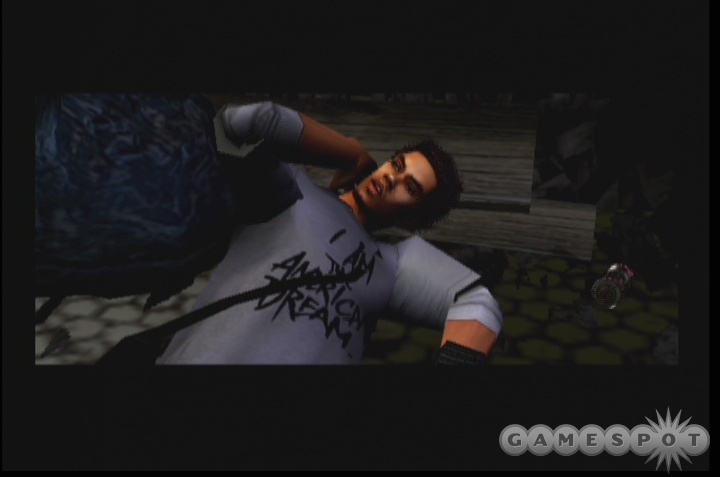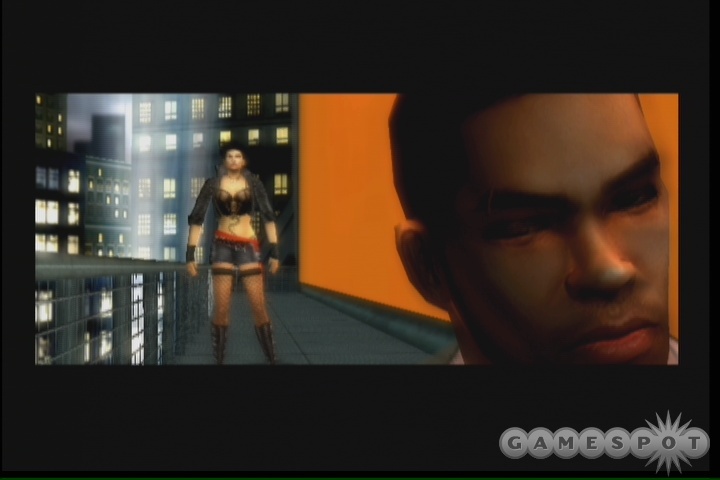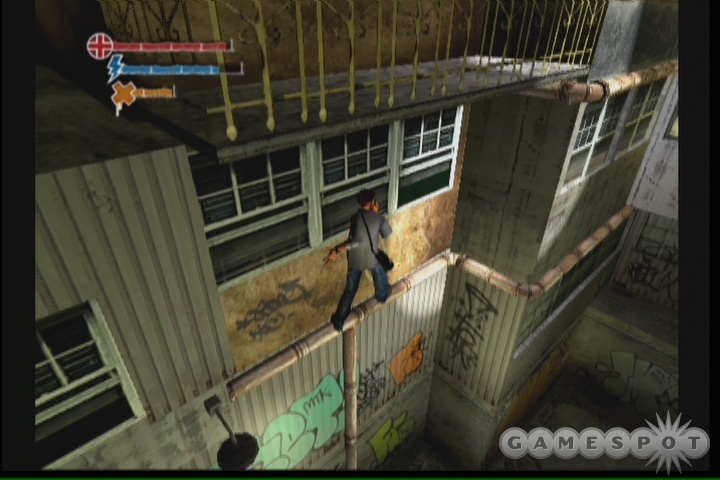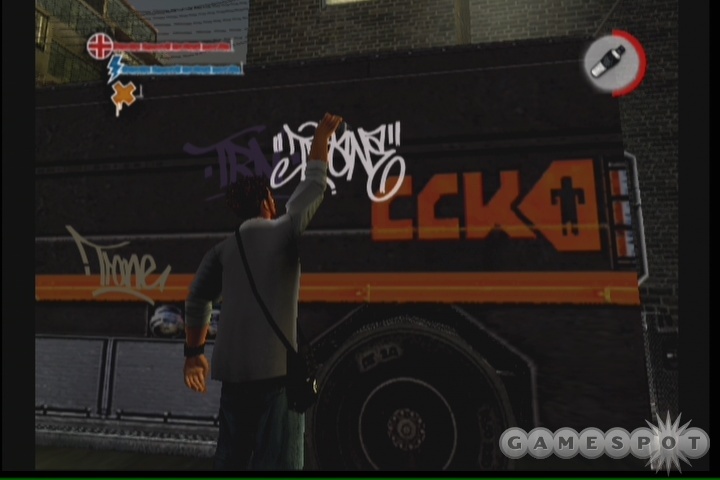Getting Up is a reference to getting your name up on the wall, not necessarily climbing up to huge heights to do so. But in Marc Ecko's new graffiti-laced action game, Getting Up: Contents Under Pressure, you'll have plenty of chances to do both. As a mixture of third-person fighting, Prince of Persia-like acrobatics, and frequent stops to get your name up on various surfaces around the near-future city of New Radius, there's a good deal of variety to the action in the game. But Getting Up has more to offer than just exciting gameplay. The story, dialogue, soundtrack, and look of the game all contribute a great deal to the flavor and authenticity of the package. The end result is an interesting and often-exciting adventure that should be appealing to most action-game fans, but will probably hold extra appeal if you're at all interested in graffiti and the culture surrounding it.

The game puts you in the role of a writer named Trane. We mean writer in the "likes to write his name on walls with markers, stickers, and paint" sense. The game opens with Trane hanging off the side of some sort of flying ship and wondering how, exactly, he got himself into this predicament. The rest of the game is, for the most part, one big flashback. But never fear--you'll eventually deduce how, exactly, Trane got himself into that mess. What starts out as a simple coming-of-age, lone-graffiti-artist-against-a-rival-gang sort of tale eventually goes into a completely different direction. When you start out, you'll be motivated to strike back against the Vandals of New Radius, or VaNR. But by the end of the game, you'll have taken things to that proverbial "other level," where you'll be lashing out at the government from behind a paint roller. The game essentially becomes Turk 182 at some point.
New Radius is, in effect, a retro-futuristic take on New York City. If you've followed graffiti culture at all (or if you watch the interesting 30-minute documentary on the topic that comes with the limited-edition version of the game), you'll know about things like New York's silver, graff-proof clean trains, which were easily buffed at the station and made sure that any graffiti applied lasted for only a day. These same trains get rolled out into New Radius as part of the mayor's efforts to clean up the city. But while you'll notice some elements of old New York in there, New Radius is really a near-futuristic setting. The mayor enforces the streets with the help of jack-booted armored troops known as the CCK. In addition to these elite orange-and-silver guards, you'll also encounter lesser resistance from the Vandal Squad, regular cops, and, of course, writers from rival gangs. Overall, the setting and the storyline provide a great deal of atmosphere to the game, and authentic-sounding dialogue further helps things along.
That dialogue is presented by a wide array of actors and actresses, as well as a few rappers. Talib Kweli provides the voice of Trane, and 3rd Bass' MC Serch gives Trane the gas face in his role as your graffiti rival, Gabe. You'll also hear P. "Leave off the P." Diddy, Adam "Still the best Batman" West, Charlie Murphy, Giovanni Ribisi, and more. With few exceptions, the voice work sounds great, and their work brings some real weight to the proceedings.
The gameplay in Getting Up is usually structured like this: You get into a new area, and there are one or more primary targets that you have to get to and paint. There are also plenty of secondary surfaces that you can paint on to earn additional rep points, which figure into the game's unlockables. Finally, there are also freeform challenges that ask you to, for example, use a marker tag 12 times on one roll-up door before time expires. To help find all of these spots, you can go into an intuition view mode that puts large Xs on your targets for a few seconds. Additional (and licensed) icons appear in the levels that let you unlock additional songs, and you'll also be able to snap photos of tags left behind by legends. Some of those legends even turn up in the game, though they're really only there to quickly advance the story--you don't have much actual interaction with them.

Actually painting in Getting Up is a pretty easy process that doesn't take a whole lot of skill. When you get near a surface that's part of an objective, an outline of your tag or piece will appear. You can change the size of it or cycle between a few different options, but then you hold down the paint button and go to work. You need to move your arm around to paint, and if you remain in one spot for too long, you'll cause drips. In addition, you're trying to beat a clock. If you cause drips, fail to beat the timer, or don't make your piece big enough, you won't earn the maximum amount of rep for that spot. Since some of the unlockables you get with rep points include increased damage with weapons and a few other handy new fighting moves, it's in your best interest to go as big and as quickly as you possibly can--while still watching out for drips, of course. At the start of the game, painting takes a fair amount of time. But right around the part of the game where you'll probably start to feel that it's tedious, you unlock the ability to paint much faster. There's an increased danger of drips when painting in fast mode, but it's still not very difficult.
While there's an element of stealth involved in Getting Up, there's still plenty of face-to-face, hand-to-hand combat to get through. If you're quiet upon entering an area, you can sneak up behind a guard, opposing writer, or other enemy and clock them over the head with a can of paint for a stealth kill. But once spotted, you'll use punches and kicks to get the job done. The fighting system starts out very simple, but over time, you'll earn new moves that make it more interesting and make you more powerful. Because the enemies also grow in power over time, the combat stays challenging--though never really superdifficult. Once you've figured out the ins and outs of beating up cops, you should be able to take on three or four of the CCK's silver guard without a whole lot of trouble. But you'll usually get into situations like that only if you aren't careful with the stealth.

The third element of Getting Up's gameplay is climbing and the occasional acrobatic maneuver. While you won't be running along walls or anything insane like that, the game does have a sort of Prince of Persia-like feel to it. Usually, figuring out how to get up to a high spot is where the game gets a little challenging, but you're rarely left wondering what to do next. You can climb up drain pipes, jump from a hanging position, wall jump, shimmy sideways along ledges, and basically perform the sorts of climbing and hanging moves you'd expect from, say, a Tomb Raider game. The game's controls are loose and forgiving. This means that if you see a pole that you want to jump to and grab, chances are that you not only can do it, but you'll also probably get it on your first try. In a couple of spots, you'll even get to rappel down huge walls and swing back and forth. All of the different gameplay elements merge really well and give you a real sense of variety across its approximately 13-15-hour story. As far as replay value goes, there isn't much reason to go back through and get maximum reputation in each level, as you'll clear out the unlocks list pretty easily as long as you're quick with the paint and hit most of the secondary spots. One of those unlocks is a two-player-only "beat down arena" mode, but this fighting mode doesn't really add a lot.
This game is best played with a gamepad. While the PC version does have keyboard and mouse support, you're doing so many different things in the game that it's really not optimal to use them. If you have a wired Xbox 360 controller, the game detects it as such and autoconfigures itself to work with the controller just fine. The PC version of the game is graphically on par with the Xbox version for the most part, though it also comes with much longer load times than either of the console games, for some reason.
In addition to the great voice and solid script, the rest of the audio in Getting Up is terrific. The sounds of tagging, whether it's the sound of an aerosol can being shaken or a marker squeaking as you hit the wall, sounds just right. Combat has an appropriately bass-heavy sound to it that helps make the attacks give off the impression that they hurt. And the soundtrack is easily one of the best licensed-game soundtracks ever put together, not only with its selections, but also with how the songs are used. Getting Up has been scored like a movie, with different bits of music tied to different portions of the game. A lot of the incidental music is done by the still-somehow-underground producer, RJD2. But there's a lot of stuff with lyrics here, too, including standout tracks from Kanye West-protégé Rhymefest, and a track that teams Talib Kweli up with hip-hop legend Rakim. System of a Down's Serj Tankian contributes a hectic, hyper remix of Notorious B.I.G.'s classic "Who Shot Ya," and Pharoahe Monch also turns in a track that fits with the action--including some of the game's climactic moments--very well. There are a lot of other songs on the soundtrack that don't actually appear in the game, but show up on the menus. As if to show that, yes, they did their homework, Grand Wizard Theodore's "Subway Theme," which some may remember from the classic graffiti-related film Wild Style, is among those songs. While not all of these songs appear on the soundtrack CD that comes with the limited-edition version of the game, enough of them do to make it worth your while (and the extra $10). Really, the only bad thing we noticed about the audio is that it sometimes cut off a little bit during in-game cutscenes, and some phrases from the standard enemies get repeated a little too often.

Getting Up has a unique and effective visual style to it that gets across the look of urban decay extremely well while still doing justice to the enemy designs, especially that of the CCK troops. Trane changes his look a little bit as you proceed through the game, which is pretty cool. The game handles its large environments well, though you'll notice a few spots here and there where the usually-smooth frame rate takes a dip. Also, the graffiti in the game really looks great. As you go along, you'll frequently unlock new murals, wild styles, wheat pastes, posters, tags, and more, so there's always something new to put up. Unfortunately, you'll occasionally see the graffiti decals shimmer in and out of the backdrop, and in the Xbox version we saw a spot or two where the graffiti seemed to be floating an inch or two above the train, instead of actually looking like it was painted on the train. As a whole, though, the game's visuals look great.
It's easy to look at a game that has a non-gamemaking fashion designer's name right in the title and assume that it's going to be some sort of flashy, style-over-substance licensed product, but Atari, The Collective, and Ecko have effectively teamed up here and put together a game that has plenty of flashy style, but is a quality game underneath all that flash. If you happen to be at least slightly interested in graffiti, you'll get a lot out of the game. If you aren't, you'll probably still be able to appreciate a lot of what the game does, and you just might learn a little something along the way.